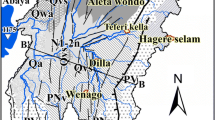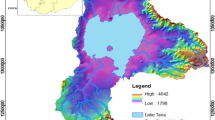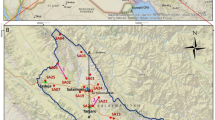Abstract
Significant upward movement of mineralized water takes place in the Puebla aquifer system. Preferential groundwater flow paths related to the geological structure and the lowering of the potentiometric surface are suspected to be the prime factors for this intrusion. A combined approach of geochemical and isotope analyses was used to assess the sources of salinity and processes that are controlling the changes in groundwater chemical composition in the Puebla aquifer. Geochemical and isotope data indicate that the likely source of increased solutes is mineralized water from the dissolution of evaporites of the Cretaceous age at the base of the Upper deep aquifer, which is deeper than the intakes of the shallow wells. Dedolomitization and cation exchange seems also to occur along flow paths where sulphate concentrations tend to increase. The deep regional flow paths controls the chemical stratification of groundwater in response to decreased heads through interconnecting vertical and horizontal pathways, such as in the Fosa Atlixco. The results also suggest that high sulphate concentrations originating in the Lower deep aquifer are currently affecting shallow production wells. It is concluded that hydrodynamic aspects together with hydrogeochemical characteristics need to be taken into account to correctly explain the hydrochemical evolution in the stratified aquifer.










Similar content being viewed by others
References
André L, Franceschi M, Pouchan P, Atteia O (2005) Using geochemical data and modelling to enhance the understanding of groundwater flow in a regional deep aquifer, Aquitaine Basin, south-west of France. J Hydrol 305:40–62
Arroyo N (2005) Análisis del origen de la contaminación por azufre del sistema acuífero del valle de Puebla mediante análisis isotópicos (Analysis and origin of the contamination for sulfur of the aquifer system of the Puebla Valley using isotope analysis). Tesis de Maestría, Universidad Autónoma del Estado de México, 130 p
Busby JF, Lee RW, Hanshaw BB (1983) Major geochemical processes related to the hydrology of the Madison aquifer system and associated rocks in parts of Montana, South Dakota, and Wyoming. US Geol Surv Water Resour Invest Rep 83-4093, 180 p
Clark ID, Fritz P (1997) Environmental isotopes in hydrogeology. Lewis Publishers, New York, p 328
Claypool GE, Holser WT, Kaplan IR, Sakai H, Zak I (1980) The age curves of sulfur and oxygen isotopes in marine sulfate and their mutual interpretation. Chem Geol 27:199–260
Cortecci G, Dinelli E, Bolognesi L, Boschetti T, Ferrara G (2001) Chemical and isotopic composition of water and dissolved sulfate from shallow wells on Vulcano Island, Aeolian Archipelago, Italy. Geothermics 30:69–91
Cortés A, Farvolden RN (1989) Isotopic studies of precipitation and groundwater in the Sierra de las Cruces, Mexico. J Hydrol 107:147–153
Edmunds WM, Carrillo-Rivera JJ, Cardona A (2002) Geochemical evolution of groundwater beneath Mexico City. J Hydrol 258:1–24
EXXICO SA (1990) Estudio de actualización geohidrológica del acuífero del valle de Puebla para abastecimiento de agua a la Ciudad de Puebla (Revised geohydrological study of the Valle de Puebla aquifer carried out to provide fresh water to the city of Puebla). CNA-SARH, Mexico City
Flores-Márquez EL, Jiménez-Juárez G, Martínez-Serrano RG, Chávez RE, Silva-Pérez D (2006) Study of geothermal water intrusión due to groundwater exploitation in the Puebla Valley aquifer system, Mexico. Hydrogeol J 14:1216–1230
Freeze RA, Cherry JA (1979) Groundwater. Prentice-Hall Canada Inc., Toronto, p 552
Fritz P, Basharmal GM, Drimmie RJ, Ibsen J, Qureshi RM (1989) Oxygen isotope exchange between sulfate and water during bacterial reduction of sulphate. Chem Geol 79:99–105
Geotecnología SA (1997) Actualización del estudio geohidrológico de los acuíferos del Valle de Puebla, Puebla. (Revised geohydrological study of the Valle de Puebla aquifer system, Puebla). Sistema Operador de Agua Potable y Alcantarillado de Puebla (SOAPAP), Puebla
Gonfiantini R, Frohlich K, Araguás-Araguás L, Rozanski K (1998) Isotopes in groundwater hydrology. In: Kendall C, McDonnell JJ (eds) Isotope tracers in catchment hydrology. Elsevier, Amsterdam, pp 203–246
González AA (2002) Análisis del Comportamiento Isotópico del Acuífero de la Cuenca del Alto Lerma, en la Región del Valle de Toluca (Analysis of isotopic behaviour in the upper lerma basin in the Toluca Valley Region). Master’s Thesis, Facultad de Ingeniería (CIRA), Universidad Autónoma del Estado de México
Gu A (2005) Stable isotope geochemistry of sulfate in groundwater of southern Arizona: implications for groundwater flow, sulfate sources, and environmental significance. PhD Thesis, Department of Geosciences, University of Arizona, p 256
Hair JF, Anderson RE, Tatham RL, Black WC (1998) Multivariate data analysis, 5th edn. Prentice Hall, Englewood Cliffs, p 75
Hancox J (2005) Aspects of aquifer vulnerability in volcanic terrain: south-eastern Toluca Basin, Mexico. MSc thesis, University of Waterloo, p 210
Jensen ML, Nakai N (1961) Sources and isotopic composition of atmospheric sulfur. Science 134:2102–2104
López-Chicano M, Bouamama M, Vallejos A, Pulido-Bosch A (2001) Factors which determine the hydrogeochemical behaviour of karstic springs. A case study from the Betic Cordilleras, Spain. Appl Geochem 16:1179–1192
Mooser F (1972) The Mexican volcanic belt: structure and tectonics. Geofis Int 12:55–70
Mooser F, Montiel A, Zúñiga A (1996) Nuevo Mapa Geológico de las Cuencas de México, Toluca y Puebla (New geological map of the Mexico, Toluca and Puebla basins). Comisión Federal de Electricidad (CFE), Mexico City
Morán-Zenteno DJ (1984) Geología de la República Mexicana (Geology of the Mexican Republic). Instituto de Estadística Geografía e Informática (INEGI) y la Universidad Nacional Autónoma de México (UNAM), Mexico City
Nelson SA, Sanchez-Rubio G (1986) Trans Mexican volcanic belt field guide. Volcanology Division, Geological Association of Canada
Östlund G (1959) Isotopic composition of sulfur in precipitation and sea-water. Tellus 11:478–480
Papatheodorou G, Lambrakis N, Panagopoulos G (2007) Application of multivariate statistical procedures to the hydrochemical study of a coastal aquifer: an example from Crete, Greece. Hydrol Process 21:1482–1495
Plummer LN, Busby JF, Lee RW, Hanshaw BB (1990) Geochemical modeling of the Madison aquifer in parts of Montana, Wyoming, and South Dakota. Water Resour Res 26(9):1981–2014
Rudolph DL, Sultan R, Gárfias J, McLaren R (2006) Significance of enhanced infiltration due to groundwater extraction on the disappearance of a headwater lagoon system: Toluca Basin, Mexico. Hydrogeol J 14(1–2):115–130
Sacks LA, Herman JS, Kauffman SJ (1995) Controls on high sulfate concentrations in the Upper Floridan aquifer in southwest Florida. Water Resour Res 31(10):2541–2551
Sultan R (2001) Impacts on wetland hydrology from extensive groundwater extraction: Lerma River Basin, Mexico. MSc Thesis, University of Waterloo, p 225
Van Stempvoort DR, Krouse HR (1994) Control of δ18O in sulfate: review of experimental data application to specific environments. In: Alpers CA, Blowes DW (eds) Environmental geochemistry of sulfide oxidation, American chemical society. A.C.S. Symp 550, Washington, pp 446–480
Vázquez-Sánchez E, Cortés A, Jaimes Palomera R, Fritz P, Aravena R (1989) Hidrología Isotópica de los Valles de Cuautla y Yautepec, México (Isotopic hydrology of the Cuautla and Yautepec Valleys). Geofisica Internacional 28–2:245–264
Acknowledgments
The authors would like to express appreciation to CONAGUA and SOAPAP for their support and field assistance through various stages of this research project. The authors are also grateful to students and technicians at CIRA (UAEM) for assisting with collection of field samples. Funding was provided for the project through the National Sciences and Engineering Research Council (NSERC) and the Autonomous University of the State of Mexico (UAEM).
Author information
Authors and Affiliations
Corresponding author
Rights and permissions
About this article
Cite this article
Gárfias, J., Arroyo, N. & Aravena, R. Hydrochemistry and origins of mineralized waters in the Puebla aquifer system, Mexico. Environ Earth Sci 59, 1789–1805 (2010). https://doi.org/10.1007/s12665-009-0161-y
Received:
Accepted:
Published:
Issue Date:
DOI: https://doi.org/10.1007/s12665-009-0161-y




